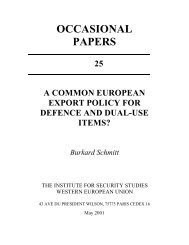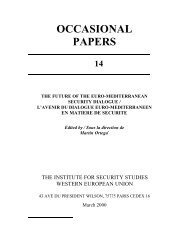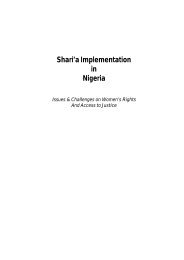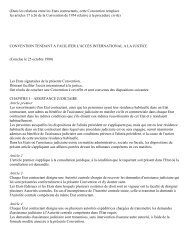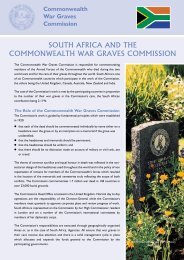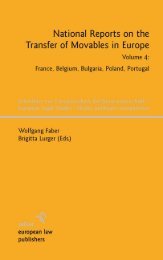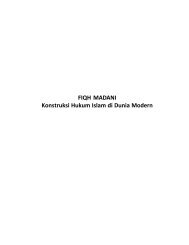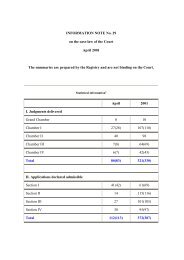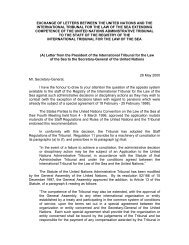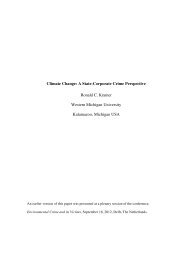Party Autonomy in International Property Law - Peace Palace Library
Party Autonomy in International Property Law - Peace Palace Library
Party Autonomy in International Property Law - Peace Palace Library
You also want an ePaper? Increase the reach of your titles
YUMPU automatically turns print PDFs into web optimized ePapers that Google loves.
3. The Numerus Clausus and <strong>Party</strong> <strong>Autonomy</strong> <strong>in</strong> the <strong>Law</strong> of <strong>Property</strong><br />
prime <strong>in</strong>terest. Conferr<strong>in</strong>g full title on a creditor <strong>in</strong>stead of only a security<br />
<strong>in</strong>terest would give him more rights and powers than he needs and<br />
would constitute an “overdistribution” (overbedel<strong>in</strong>g) of rights and powers<br />
to that creditor. The issue here is not so much one of justice as one of<br />
pragmatism <strong>in</strong> the organisation of the law: the aim of the fiducia-verbod<br />
is to provide the debtor with sufficient stand<strong>in</strong>g <strong>in</strong> law (locus standi), by<br />
way of a bare ownership right, to enable him to safeguard his <strong>in</strong>terest <strong>in</strong><br />
the asset controlled by the creditor. As a result of forc<strong>in</strong>g such parties to<br />
create a pledge <strong>in</strong>stead of transferr<strong>in</strong>g ownership for fiduciary purposes,<br />
ownership rema<strong>in</strong>s with the debtor, who therefore reta<strong>in</strong>s his locus standi<br />
and can safeguard his <strong>in</strong>terests. Furthermore, this enables him to profit<br />
from his ownership <strong>in</strong>terest by transferr<strong>in</strong>g it (subject to the security <strong>in</strong>terest)<br />
or creat<strong>in</strong>g a second right of pledge. 38<br />
Similar reasons expla<strong>in</strong> the prohibition of fiducia cum amico. If it is necessary<br />
for one party’s property to be adm<strong>in</strong>istered by another who is more<br />
careful or competent, it does not make sense, accord<strong>in</strong>g to Meijers, to<br />
deprive the <strong>in</strong>competent party of his full ownership and grant it to the<br />
other party, who requires only powers of adm<strong>in</strong>istration. In such cases,<br />
the legislature should opt to confer those powers on the adm<strong>in</strong>istrator<br />
and give them effect aga<strong>in</strong>st both the owner himself and third parties. Instead<br />
of the English-style trust, Meijers proposed to expand the old Dutch<br />
concept of bew<strong>in</strong>d. 39 The essence of this concept is that the party whose<br />
property is made subject to the bew<strong>in</strong>d by a court (the onderbew<strong>in</strong>dgestelde),<br />
rema<strong>in</strong>s the owner, but loses a number of his ownership powers: the powers<br />
of adm<strong>in</strong>istration and of disposal are conferred on the adm<strong>in</strong>istrator<br />
(bew<strong>in</strong>dvoerder). Thus, the adm<strong>in</strong>istrator gets the powers he needs, and<br />
the <strong>in</strong>competent party is not deprived of more than is necessary.<br />
In the light of this, two phenomena <strong>in</strong> current Dutch property law should<br />
be mentioned. On the one hand, there is the implicit statutory recognition<br />
of the retention of title clause as a valid security device that can be<br />
<strong>in</strong>voked aga<strong>in</strong>st other creditors of the buyer. Retention of title is functionally<br />
so close to a transfer of ownership for fiduciary purposes that the difference<br />
<strong>in</strong> treatment is hard to expla<strong>in</strong>. Equally important is the pragmatic<br />
dimension: the seller does not need more than a security <strong>in</strong>terest, whereas<br />
38<br />
See Struycken, o.c. 2007, § 7.4.2.<br />
39<br />
E.M. Meijers, De trustee en het burgerlijk recht (recensie preadviezen BCN<br />
1927), WPNR 2998 (1927), p. 413-416, VPO III, p. 184. See Struycken, o.c.<br />
2007, § 7.5.3.<br />
T.H.D. Struycken 75<br />
© sellier. european law publishers<br />
www.sellier.de



